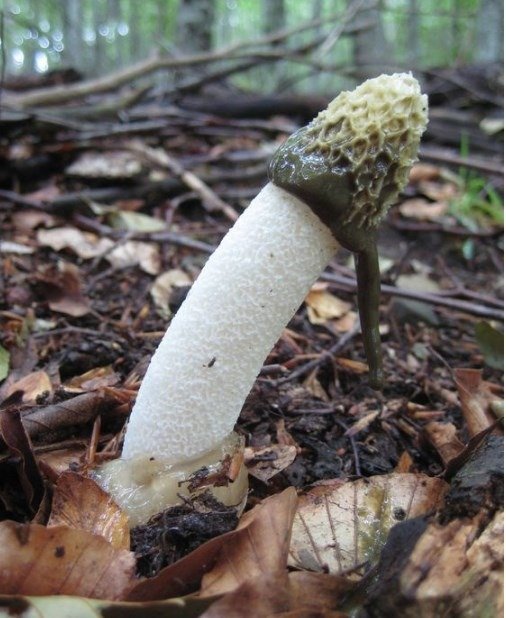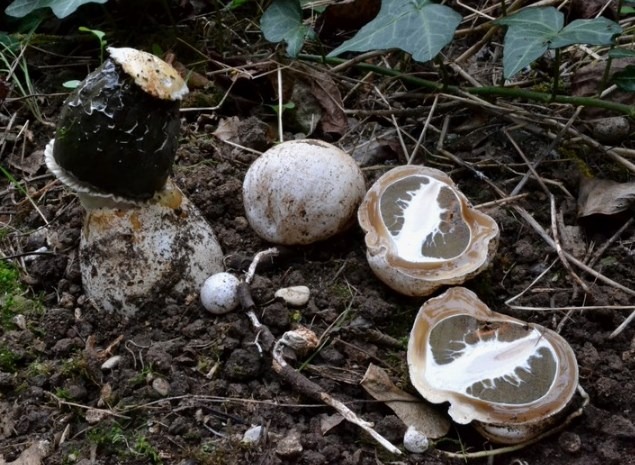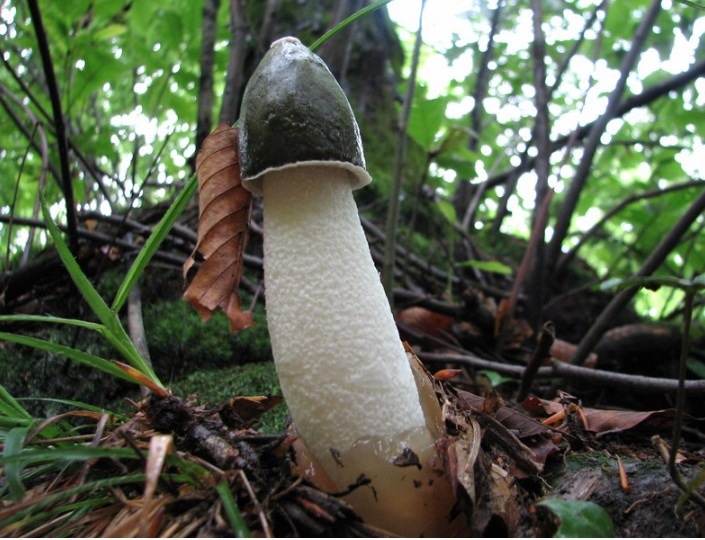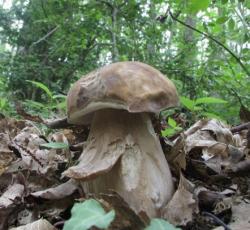The most known fungus of the family of the Phallaceae is surely the Phallus impudicus, whose scientific name comes from the Latin and can be translated as “Impudic phallus”.
It owes its name to its shape because, once it has developed, it remembers the male part and also for this reason it is called ” phallus mushroom” or “common stinkhorn”.
Indice
Introduction to common stinkhorn mushroom
It belongs to the genus Phallus, to the family of the Phallaceae, to the order Phallales and to the class of the Gastromycetes, those fungi which, in the initial phase, have the fertile part contained inside a membrane called glebaLa parte interna fertile, che produce le spore, del corpo fruttifero dei funghi Gasteromiceti. Nel caso dei Tuberali, l'imenio tappezza l'interno di cavità chiuse. Il Peridio, una cuticola esterna persistente, che si apre solo a maturità per consentire di liberare..., which, once ripe, will break allowing the spores to come out.
Another typical characteristic is its disgusting smell of rotting meat that emanates as an adult and that makes it recognizable even at a distance of meters.
This smell is emanated by a mucilage containing the spores and located on the upper part of the carpophore (body of the fungus).
The unpleasant smell of the Phallus impudicus attracts flies and insects that touch it and get dirty and can spread the spores even in places far from the fungus.
When young, it looks like an egg from which one of its vulgar names, the “devil’s egg”, comes.
Other Names of Phallus impudicus
As mentioned in the previous paragraph, the Phallus impudicus is also known by the name of common stinkhorn or, in Italy, devil’s egg and phallus fungus. When young it has the appearance of an egg from which comes one of its vulgar names “devil’s egg”.
Another common name in Italy is “satirone”.
In English it is called “Stinkhorn”, i.e. “stinking horn”. Other synonyms or obsolete names can be read on the page of this mushroom on wikipedia.

Description of Phallus impudicus
Now let’s talk about the physical and morphological characteristics of Phallus impudicus
It can be said that the common name well defines the appearance in the juvenile phase, while the scientific one captures the appearance in adulthood, ie the phallic form that resembles a real penis.
Cap
The common stinkhorn is egg-shaped when young and is enclosed in a white volvaIl residuo del velo generale, che rimane attaccato alla base del gambo. Può essere formata da tessuto friabile o membranoso. called peridium.
It may be confused with other similar edible mushrooms, but when you open it, you can see that it is not because it is full of a gelatinous substance.
The outer surface is covered with glutin, a sort of “skin”, the glebaLa parte interna fertile, che produce le spore, del corpo fruttifero dei funghi Gasteromiceti. Nel caso dei Tuberali, l'imenio tappezza l'interno di cavità chiuse. Il Peridio, una cuticola esterna persistente, che si apre solo a maturità per consentire di liberare..., of yellow-green colour which then becomes dark olive-green, smelly, deliquescent and contains the spores.
The glebaLa parte interna fertile, che produce le spore, del corpo fruttifero dei funghi Gasteromiceti. Nel caso dei Tuberali, l'imenio tappezza l'interno di cavità chiuse. Il Peridio, una cuticola esterna persistente, che si apre solo a maturità per consentire di liberare..., i.e. the fertile part of the carpophore, is the part on which the insects rest and which remains attached to their body, so they gradually remove it completely.
In this way, the perforated top of the hat of the phallus mushroom remains uncovered and can resemble that of a morel.
Check the gelatinous consistency of the cap of the Phallus impudicus is easy to pressure. If you section it, it is very evident the very different aspect of this fungus from the white glebe typical of the vesce.
The size of the cap varies from 3 to 5 cm in diameter.
Stipe
The stipe of the Phallus is white, robust and spongy, cylindrical and elongated.
It is completely hollow, very brittle and with wrinkles.
It has an opening at the apex around which the cap is formed.
The dimensions of the height vary from 10 to 20 cm but it can reach even 30 of them, it is white.
At the base it is surrounded by a volvaIl residuo del velo generale, che rimane attaccato alla base del gambo. Può essere formata da tessuto friabile o membranoso. with a membranous appearance that extends into the ground with a kind of root.
Flesh
When young, the flesh of common stinkhorn is fragile and delicate, white in colour, has an almost pleasant smell and vanilla and in the state of sheep it seems to be pleasant.
When adult, its smell is fetid and after the first instants it becomes even cadaveric, so much that it is perceivable even at a distance of some meters.
The taste of the flesh of Phallus impudicus is unpleasant and nauseating.
The mushroom is a non-edible species.
Spores
The spores have an elongated, ellipsoidal shape and are greenish-yellow in colour.
With dimensions of 3.5 x 1.5-2.5 µm.
Habitat of Phallus impudicus
The common stinkhorn bears fruit and grows in hot, rainy seasons from spring to late autumn.
It prefers moist soils in mixed deciduous and coniferous woods, but also grows in gardens from the plains to the hills.
It is quite easy to find it in different environments.
It is a saprophyte fungus, that is, it grows and nourishes of organic matter in decomposition, both animal and vegetable.

Mushrooms similar to Phallus
Il common stinkhorn o Phallus impudicus può essere confuso con il Phallus hadriani.
The main differences are due to the colour of the glebaLa parte interna fertile, che produce le spore, del corpo fruttifero dei funghi Gasteromiceti. Nel caso dei Tuberali, l'imenio tappezza l'interno di cavità chiuse. Il Peridio, una cuticola esterna persistente, che si apre solo a maturità per consentire di liberare..., which is darker in the hadriani, and of the volvaIl residuo del velo generale, che rimane attaccato alla base del gambo. Può essere formata da tessuto friabile o membranoso., which is pink or vinous.
It is a fungus, as already said many times, not edible and not very inviting.
In some northern European countries it is harvested and consumed in the state of sheep but deprived of peridium.
In the adult stage, due to its nauseating and cadaveric smell, it is inedible.
IDENTITY CARD
CAP COLOR: Greenish
STIPE: 10-20 cm
STIPE COLOR: white
FLESH: Whitish
SMELL: Repellent
SPORE: yellowish
HABITAT: Hardwood and Leaf Needles
Did you find what you were looking for? See also here:
- Ganoderma Lucidum
- Armillaria Mellea
- Amanita Caesarea
- Agaricus Bisporus
- Amanita Phalloides
- Coriolus Versicolor
- Flammulin Velutipes
- Marasmius Oreades
- Pleurotus Ostreatus
- Agaricus Campestris
- Macrolepiota procera

